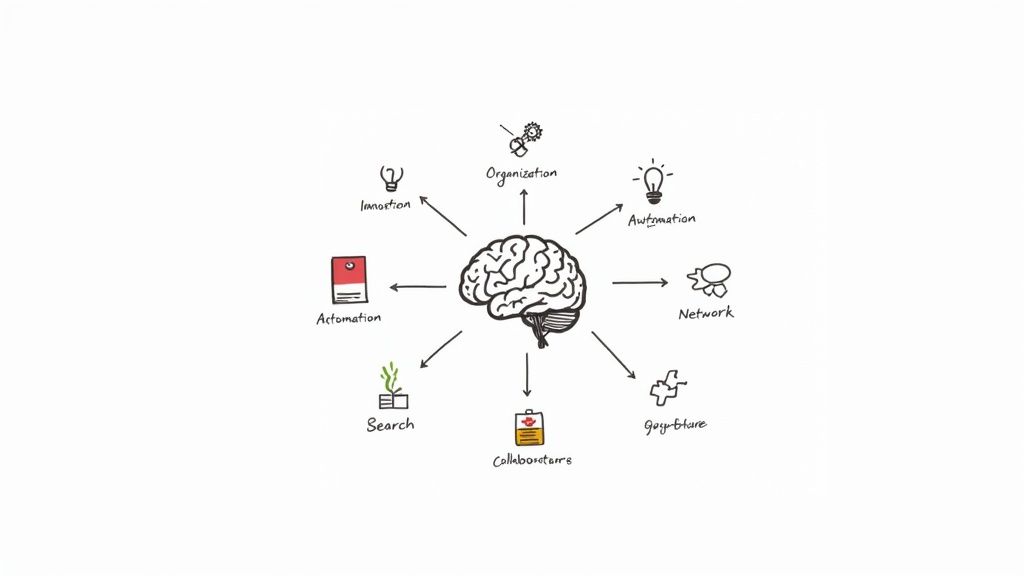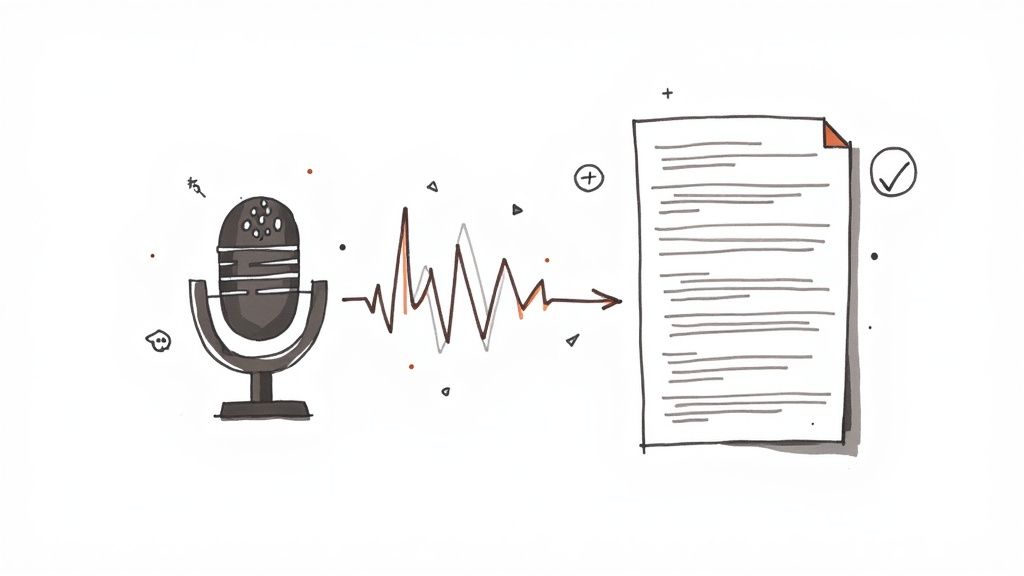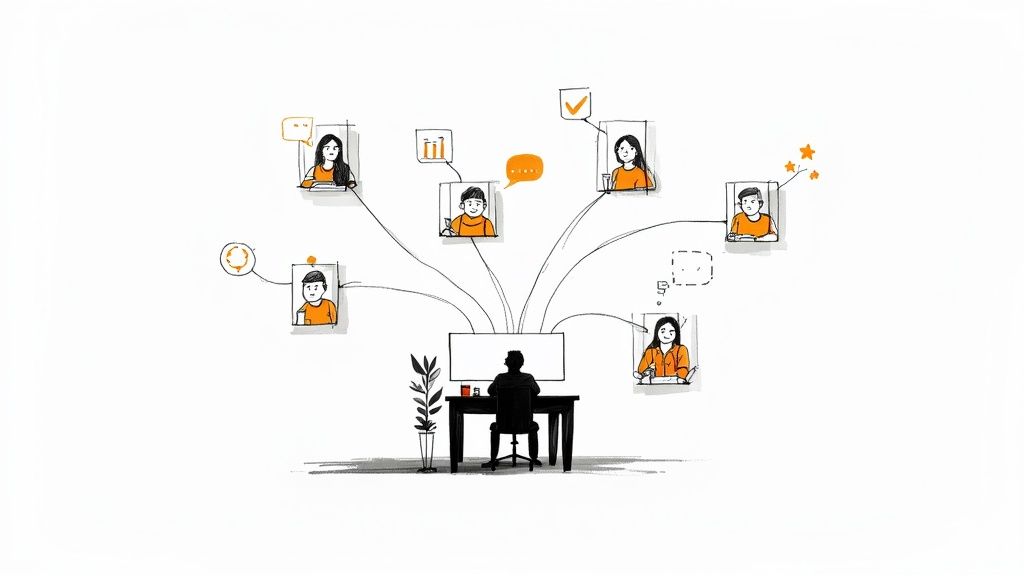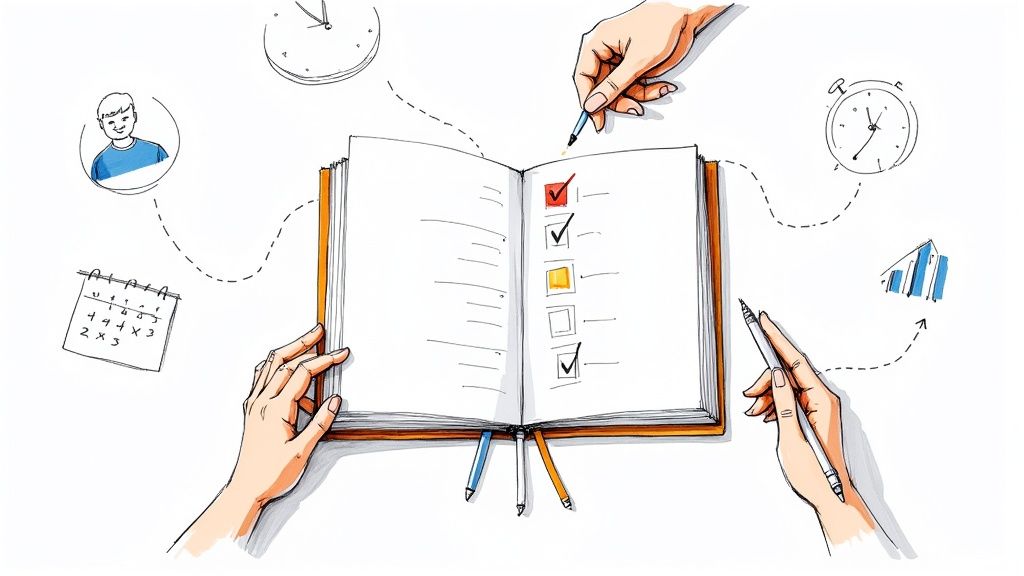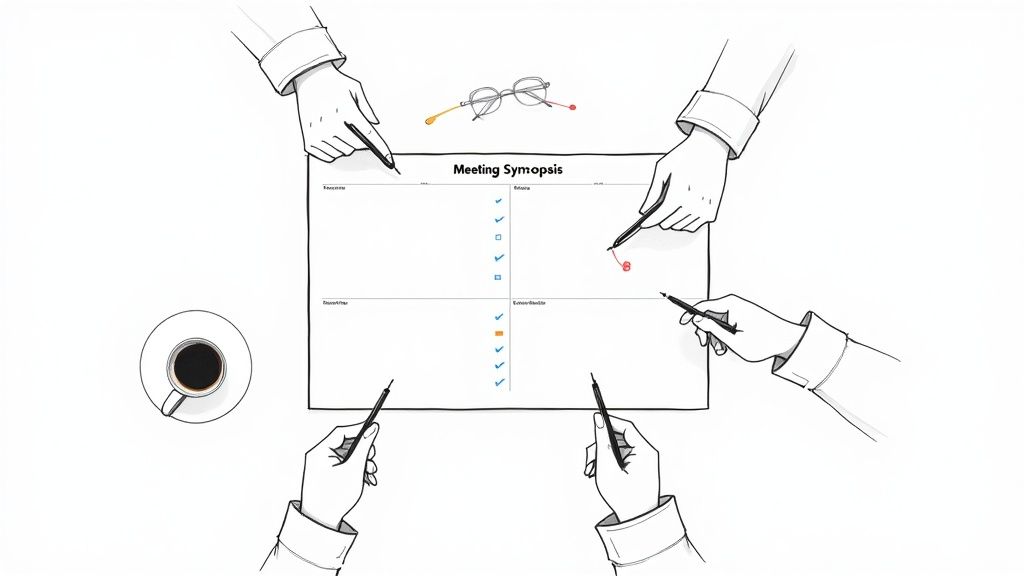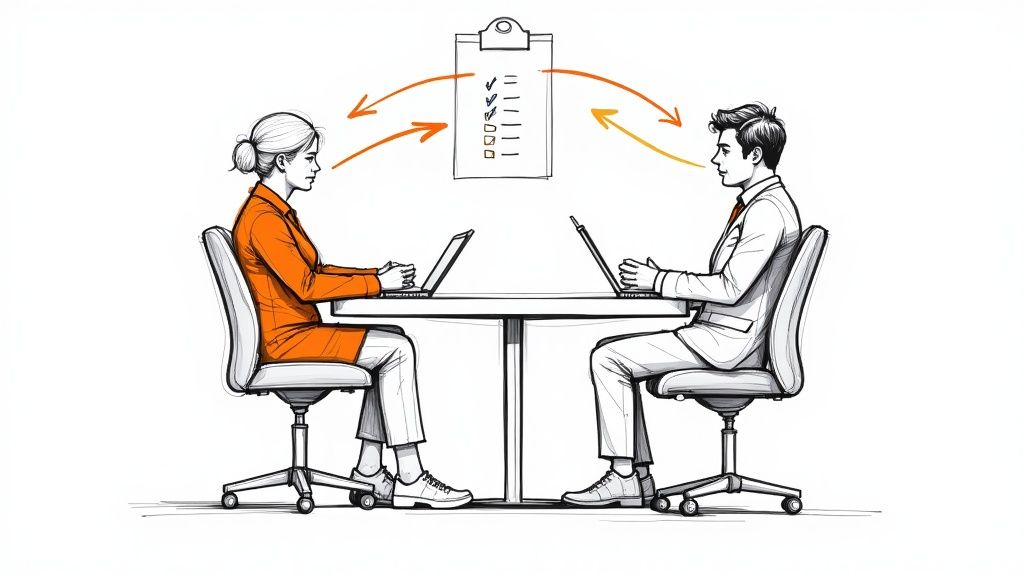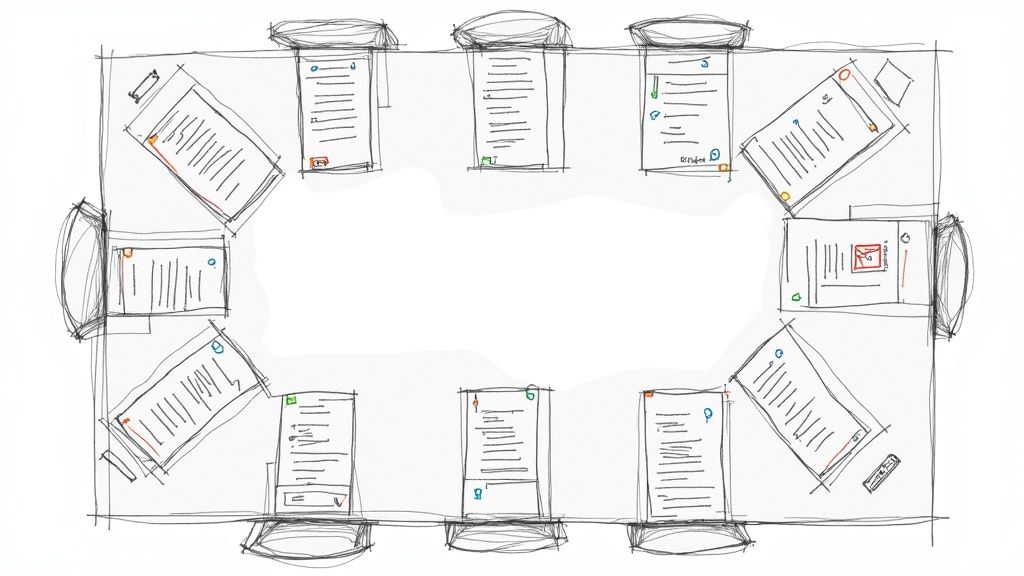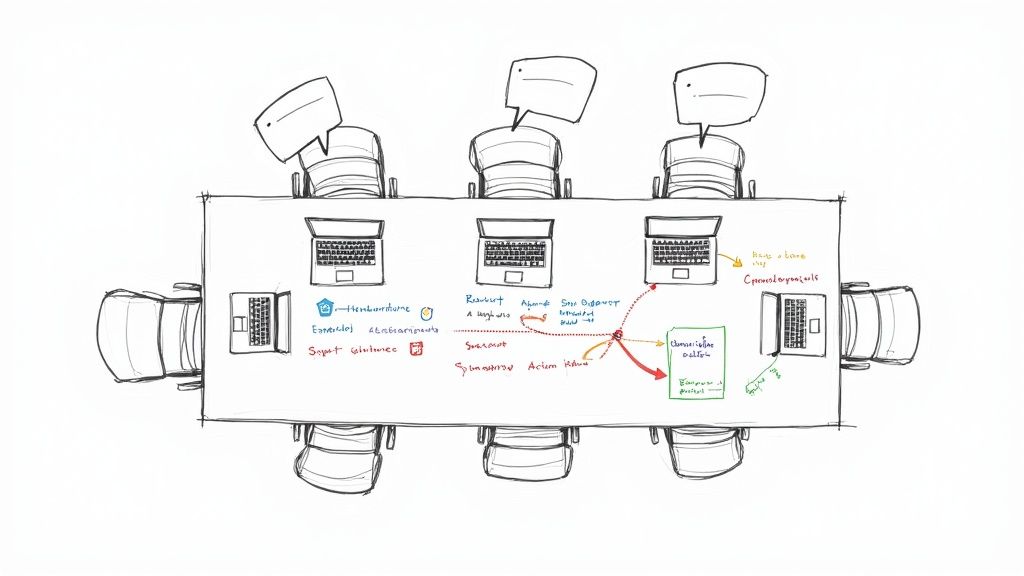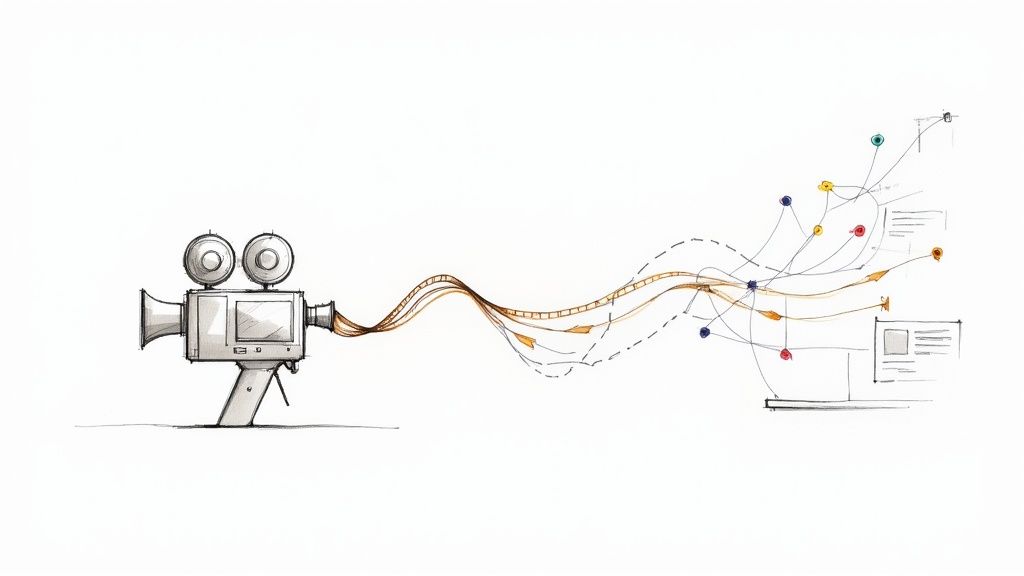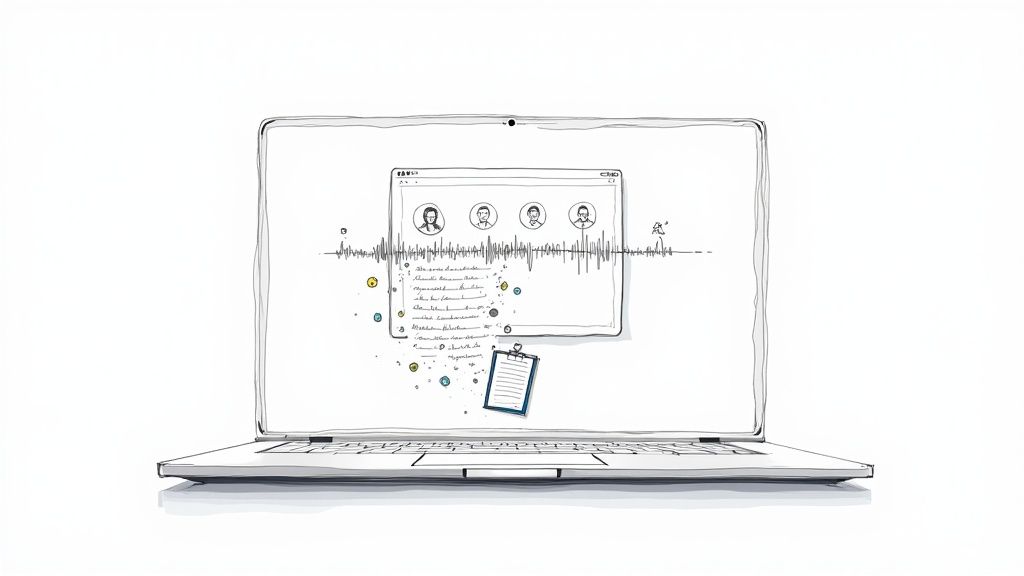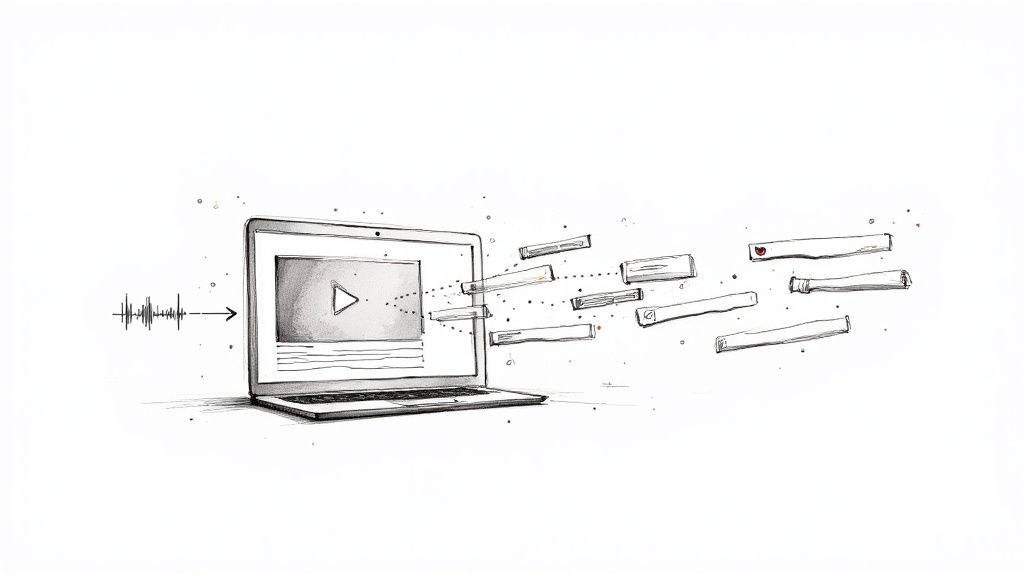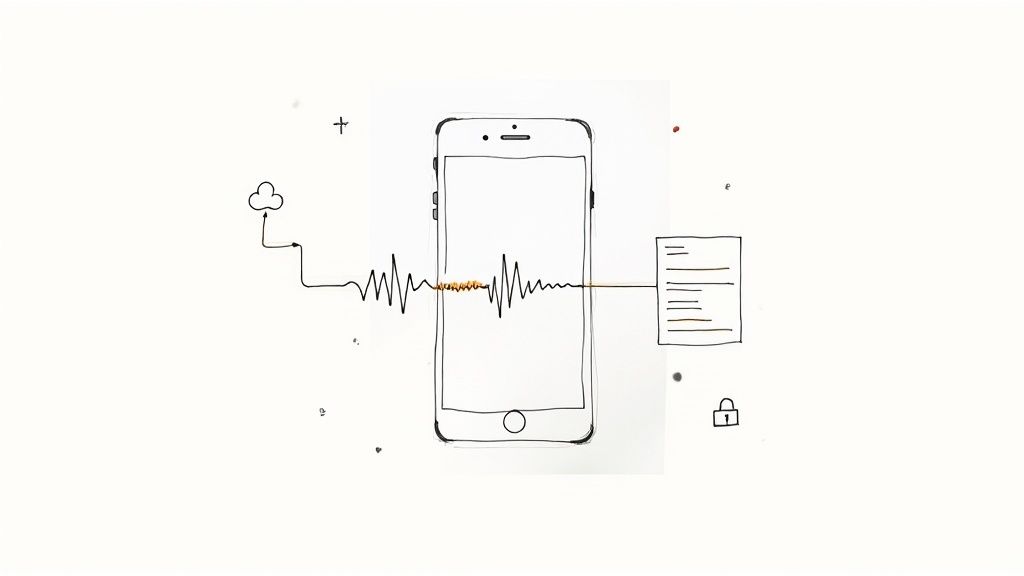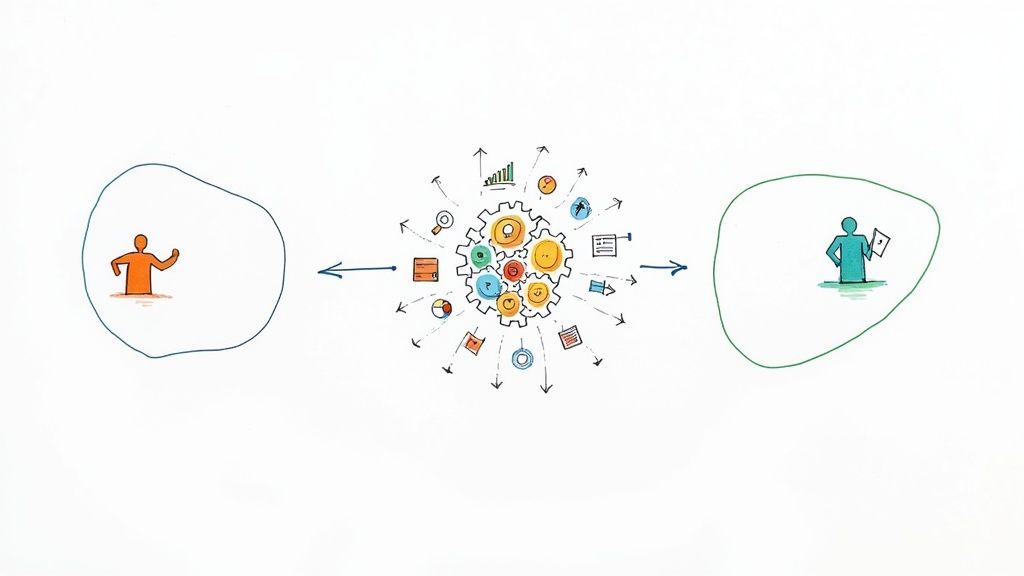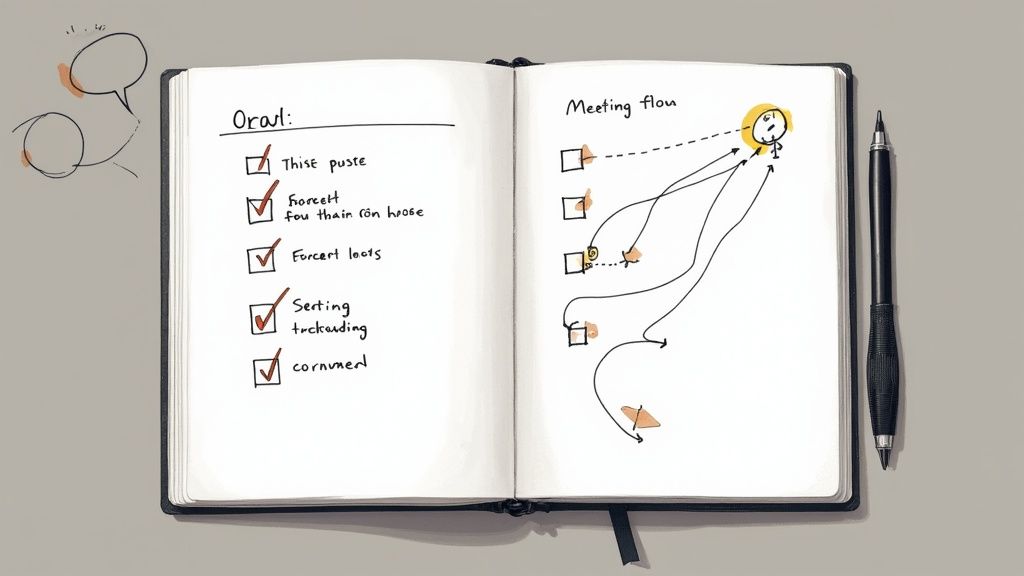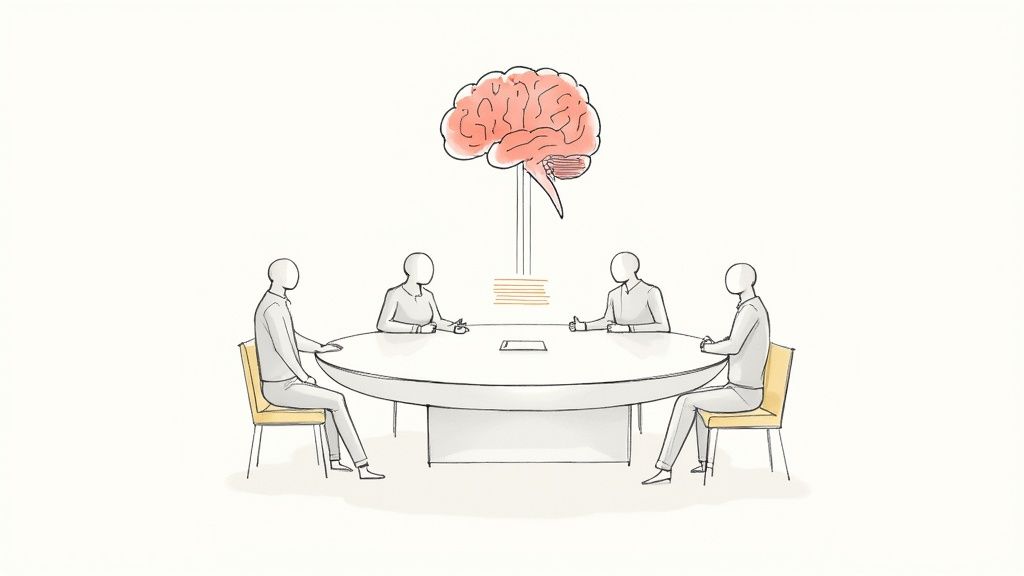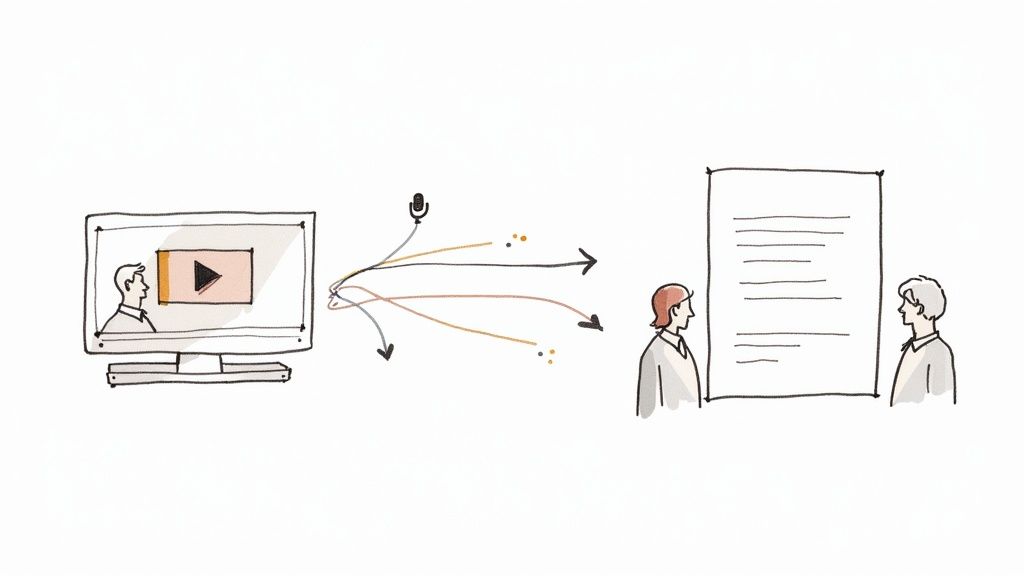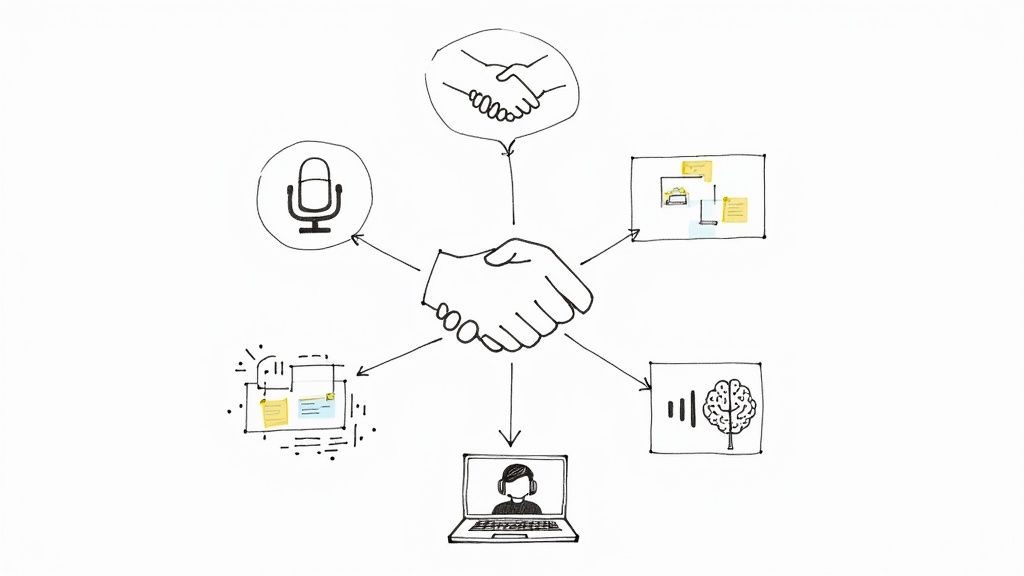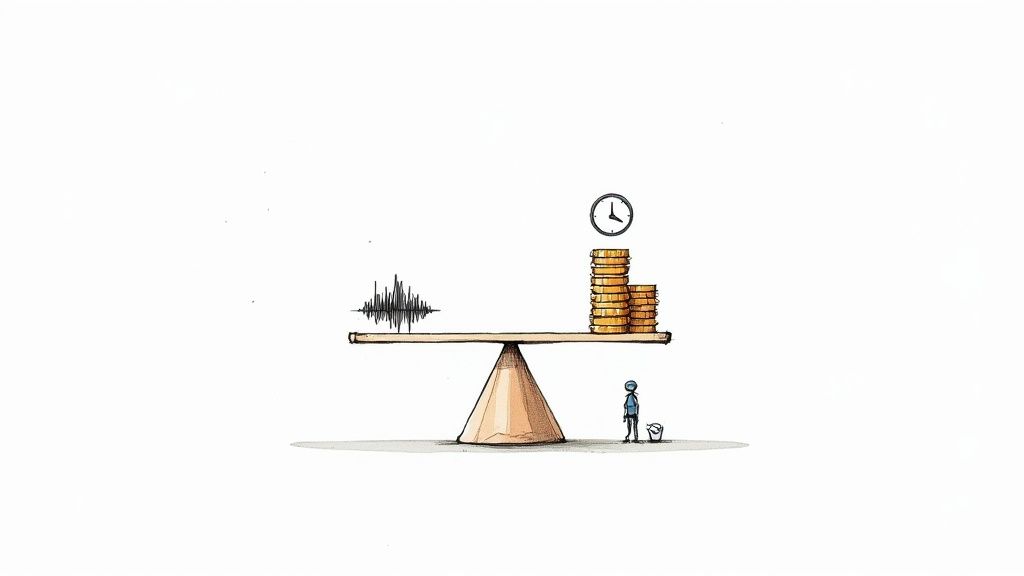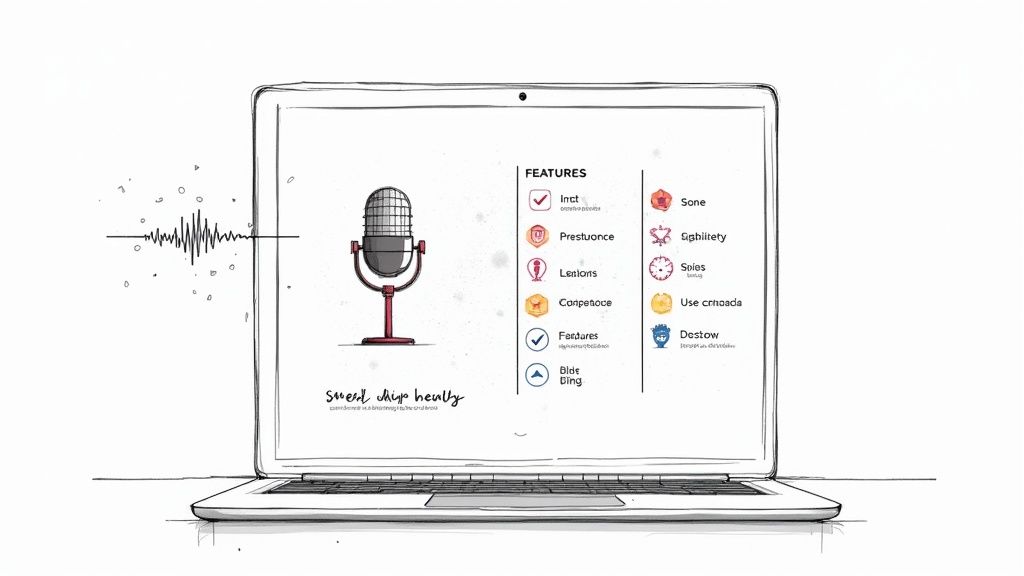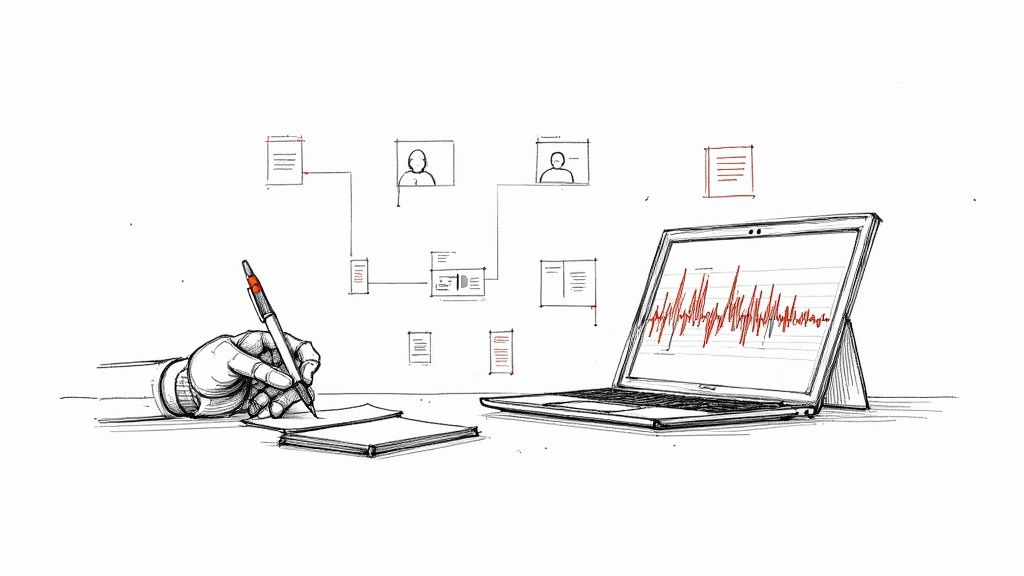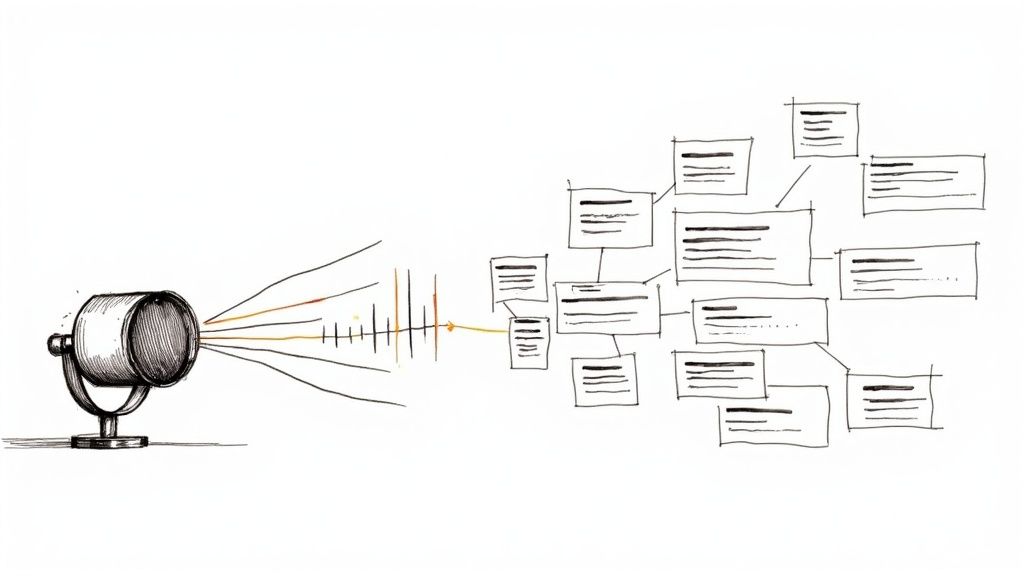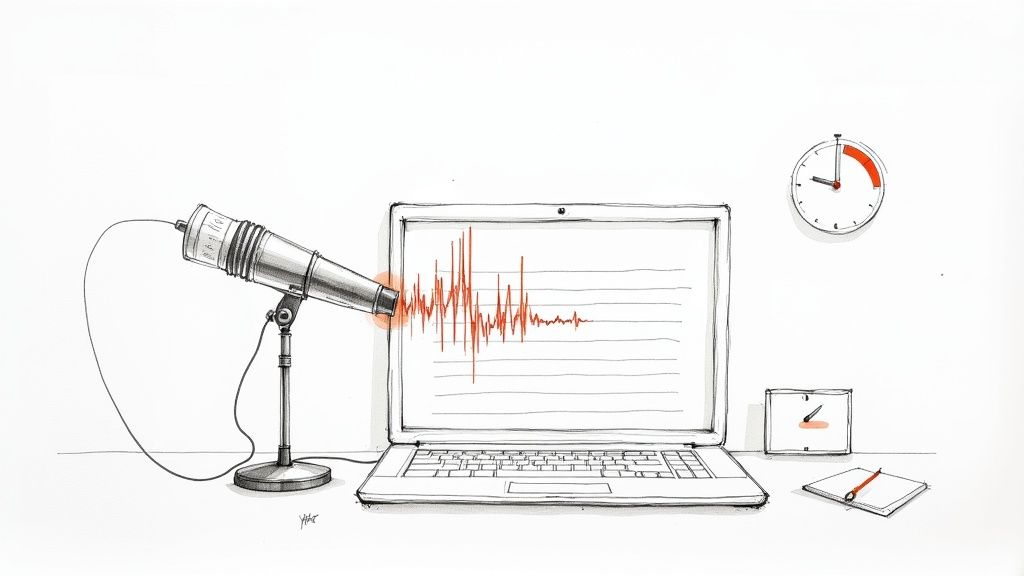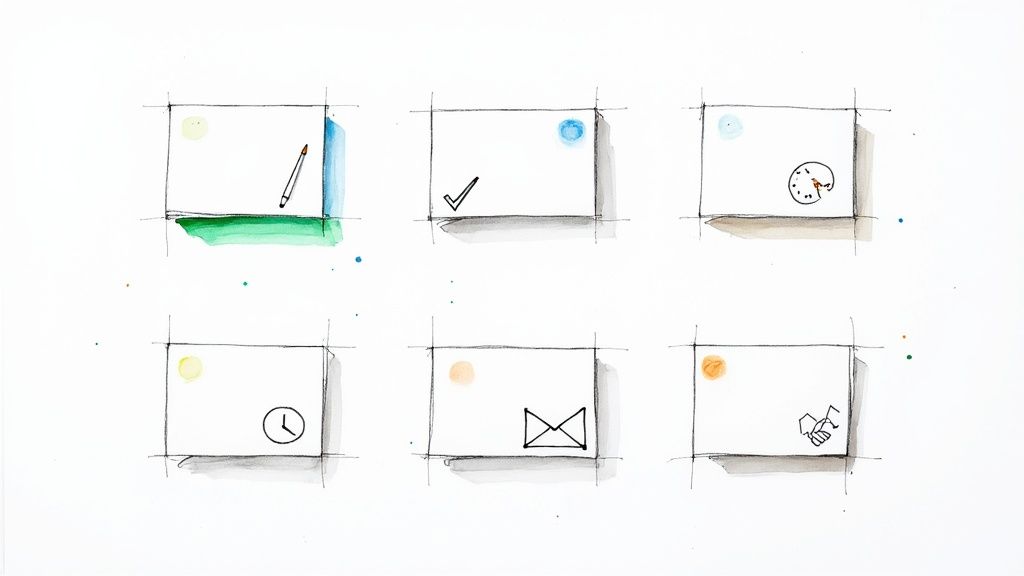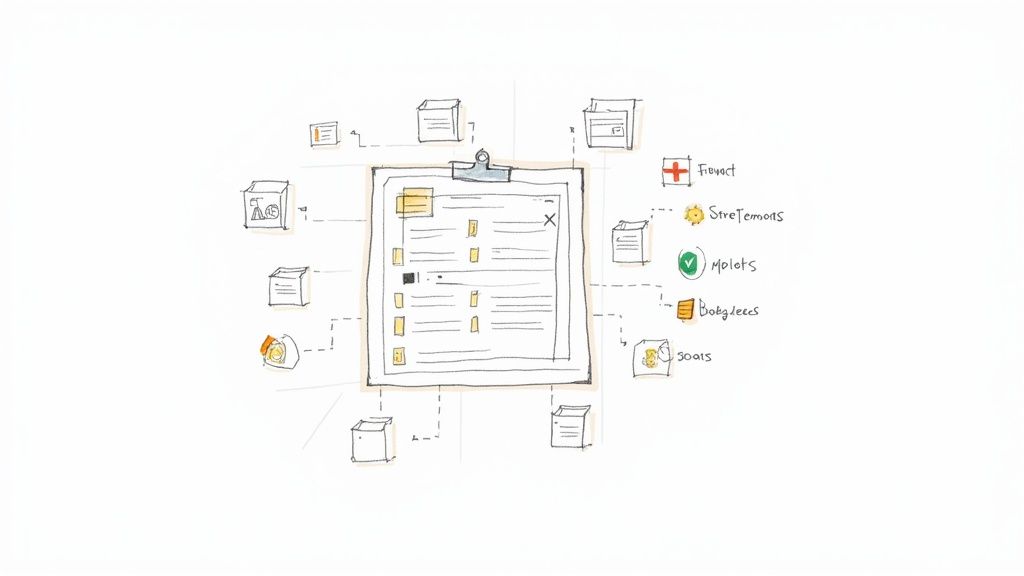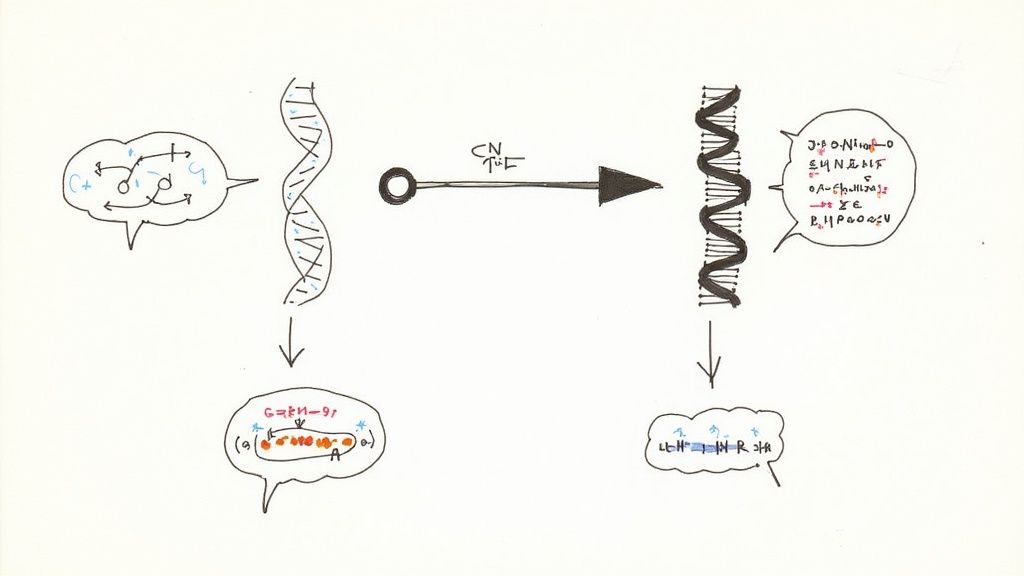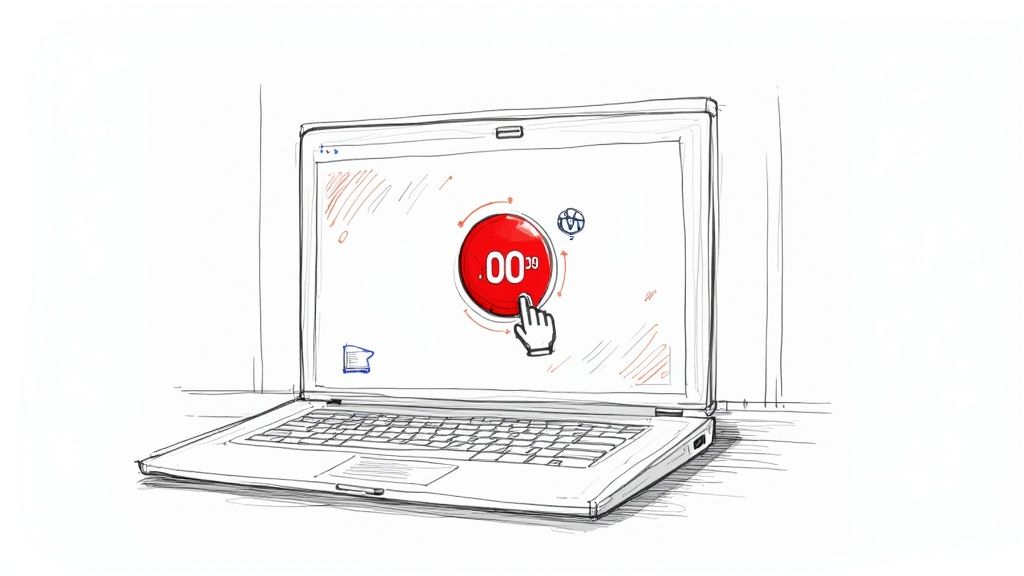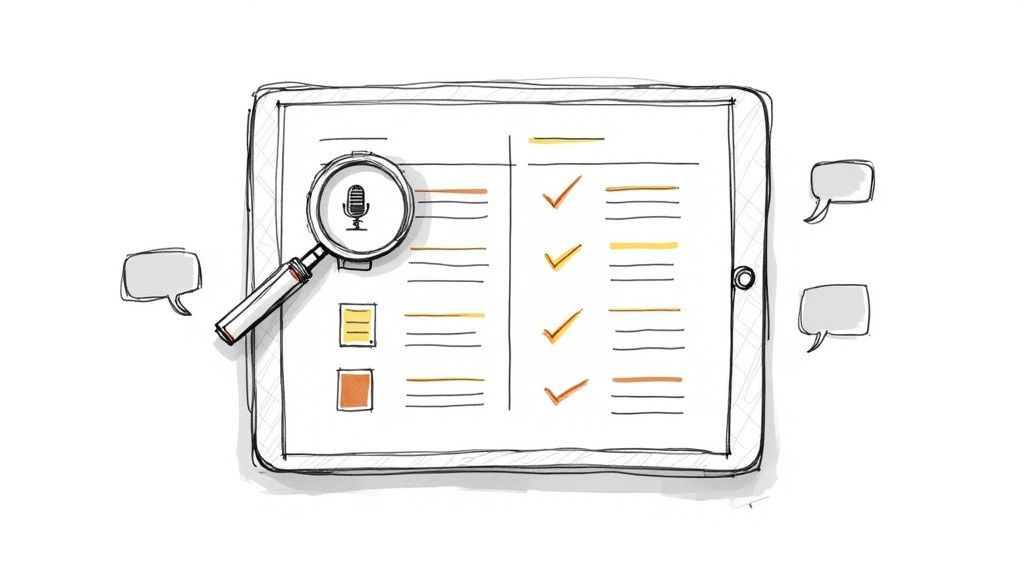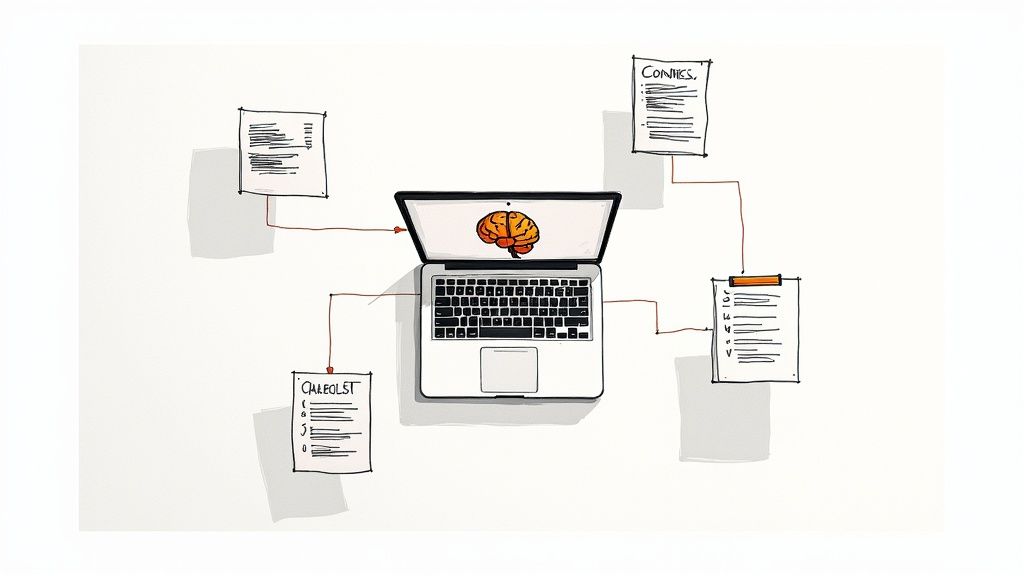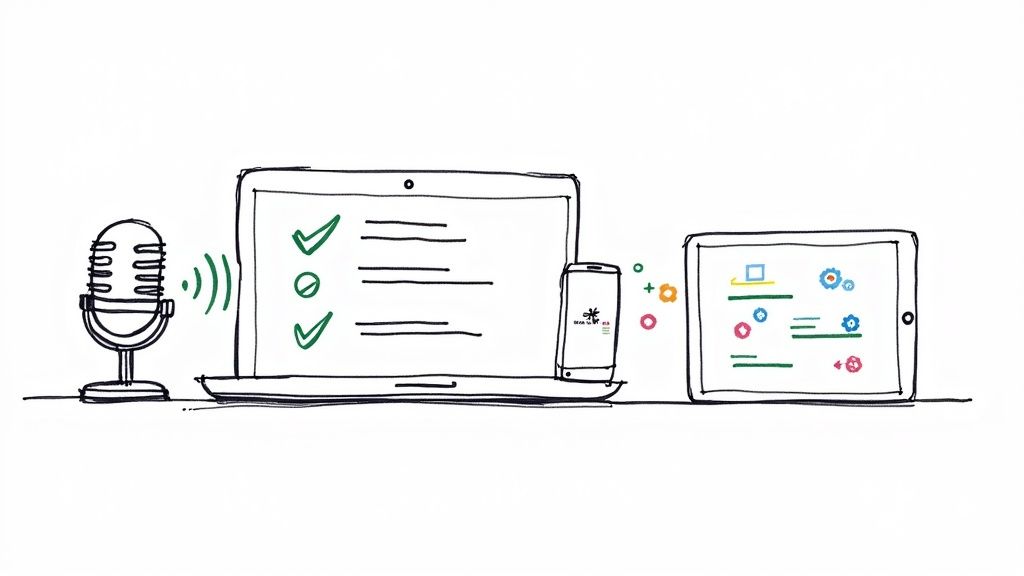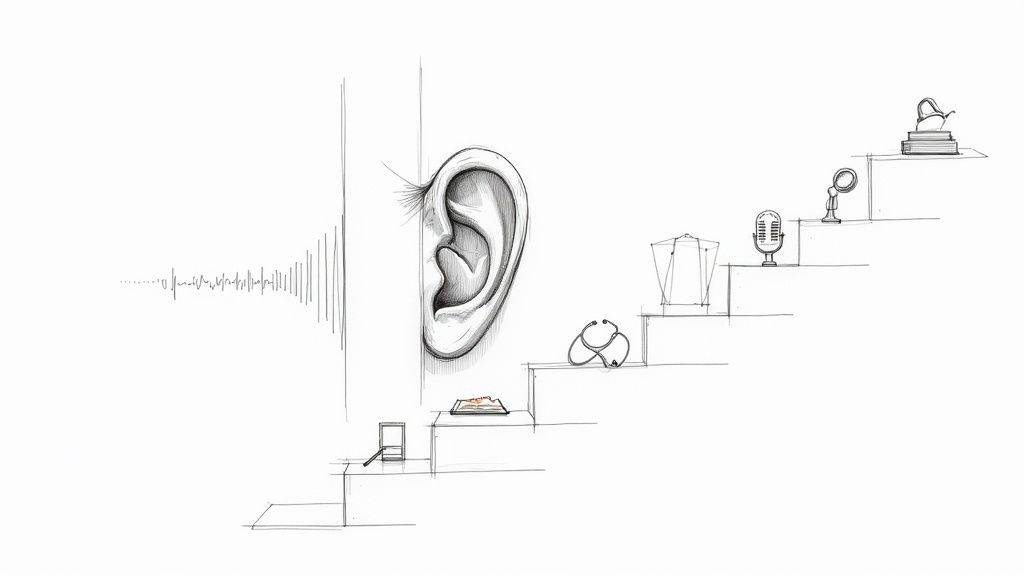Call Center Quality Assurance Done Right
So, what exactly is call center quality assurance? Think of it less like a stern hall monitor and more like a dedicated coach reviewing game tape with their team. It’s the structured process of listening to and evaluating conversations between your agents and customers.
The goal isn't to catch people making mistakes. It's about finding what works, pinpointing areas for growth, and making sure every interaction reflects your brand's commitment to excellence. This is the engine that powers continuous improvement and turns good service into great experiences.
Why a Strong QA Program Matters

At its core, call center quality assurance is how you systematically listen to what your customers are really saying and measure how well your agents are responding. It goes far beyond just ticking boxes on a scorecard; it’s a critical business function that directly impacts your bottom line, helping to shift your contact center from a cost of doing business to a hub of value creation.
An effective program isn't about randomly sampling a few calls here and there. It's about defining what an "excellent" interaction looks like, consistently measuring every agent against that benchmark, and then using that data to create targeted, impactful coaching. This builds a culture where everyone knows what success looks like and has a clear path to achieve it.
A modern QA program is built on several key pillars that work together to create a comprehensive and effective system.
Table: Core Components of a Modern QA Program
A successful call center quality assurance framework is built on these essential pillars, each with a specific objective.
These components create a closed-loop system where performance is measured, understood, and consistently improved.
The Foundation of Customer Loyalty
Your agents are the voice of your company. Every single call is a "moment of truth" that can either build up a customer's trust or tear it down. A solid QA process makes sure these moments are consistently positive, which is the bedrock of genuine customer loyalty.
By analyzing conversations, you also get a direct line into what your customers need, what frustrates them, and what they expect from you. This feedback is gold. It helps you improve not just agent skills but also your products, services, and internal processes. When customers feel like you're actually listening, they stick around.
Operational Efficiency and Risk Mitigation
Quality assurance is also a powerhouse for making your operations more efficient. By identifying the real reasons behind repeat calls or long handle times, you can fix the underlying issues instead of just patching the symptoms. This saves a ton of time and money, freeing up your team to handle more customer issues effectively.
On top of that, QA is non-negotiable for compliance and managing risk. It ensures your agents follow all necessary regulations and internal policies, protecting your business from hefty fines or reputational damage. Despite its importance, many organizations struggle to get it right. In fact, looking ahead to 2025, about 85% of contact centers say they struggle to find enough time for thorough QA, and 61% point to a lack of adequate technology as a major roadblock. You can explore more on these common contact center challenges on LLCBuddy.com.
A great QA program isn't about finding fault; it's about finding opportunities. It shifts the focus from "what went wrong" to "how can we make it even better next time," empowering agents to own their development and take pride in delivering exceptional service.
Ultimately, call center QA is the bridge connecting your high-level business goals to the day-to-day reality of your customer interactions. It gives you the data-backed clarity you need to make smart decisions, coach your team to greatness, and create experiences that customers remember for all the right reasons.
The Metrics That Truly Define Call Center Quality

If you can't measure it, you can't improve it. This old adage is the heart of call center quality assurance. Metrics are how we translate messy, complex human conversations into clear, actionable data.
But here's the catch: not all metrics are created equal. Focusing on the wrong ones won't just waste your time; it can actively steer your team in the wrong direction. The goal is to build a balanced scorecard that tells the whole story—about your agents, your operations, and most importantly, your customer's journey.
Foundational Efficiency Metrics
Let's start with the operational nuts and bolts. These are the metrics that keep the engine of your contact center running smoothly. They're all about efficiency, but you have to be careful not to treat them as the be-all and end-all.
- Average Handle Time (AHT): This one's straightforward—it's the total time an agent spends on an interaction, from "hello" to the final click of post-call work. A low AHT looks great on a spreadsheet, but if it comes at the expense of a good customer experience, you're losing in the long run.
- First Call Resolution (FCR): This measures how often you solve a customer's problem on the very first try. A high FCR is a golden indicator of agent expertise and solid processes, and it almost always leads to happier, more loyal customers.
Think of it this way: AHT measures speed, while FCR measures effectiveness. An agent who solves a tricky issue in one 10-minute call is infinitely more valuable than one who rushes through three separate 3-minute calls because the problem wasn't fixed the first time.
Customer-Centric Experience Metrics
Efficiency is great, but a truly effective call center quality assurance program is built around the customer's point of view. These metrics are your window into how people actually feel about the service they’re getting.
A truly customer-centric approach means measuring the experience, not just the interaction. It’s the difference between asking "How long was the call?" and "Did we make the customer's life easier?"
This is where we get to the heart of what builds loyalty and what drives customers away.
- Customer Satisfaction (CSAT): Usually a simple post-call survey asking, "How satisfied were you?" on a numbered scale. It's a great gut check for a specific interaction.
- Net Promoter Score (NPS): This one looks at the bigger picture by asking, "How likely are you to recommend us?" It gauges overall brand loyalty, not just a single touchpoint.
- Customer Effort Score (CES): This might be the most telling of all. It asks, "How easy was it to get your issue resolved?" A low-effort experience is one of the strongest predictors of customer loyalty.
These scores add crucial context. A low AHT paired with a terrible CES score is a huge red flag. It probably means your agents are pushing people off the phone without solving anything, forcing customers to do more work.
Advanced Quality and Performance Metrics
To get the full picture, modern QA programs dig deeper with more sophisticated metrics. This is where qualitative analysis and quantitative data really start to work together, revealing the why behind the numbers.
- Sentiment Analysis: This technology listens to the emotional tone of a call, flagging words and tones that signal frustration, happiness, or confusion. It's an incredible tool for finding the calls that need a human review right away.
- Compliance Adherence: This tracks whether agents are sticking to the script, especially for critical legal or regulatory disclosures. For many industries, this is a non-negotiable metric for managing risk.
When you look at national benchmarks, the numbers tell a fascinating story. In the US, average customer satisfaction scores for call centers tend to hover between 69 to 73 out of 100. It just goes to show how tough it is to consistently meet customer expectations. It's also telling that about 74% of centers track critical error accuracy as a core QA metric, reinforcing the industry's focus on getting things right the first time. You can dig into more of these numbers by exploring these call center statistics from Zoom.
Building Your QA Process from the Ground Up
A great call center quality assurance program isn’t something you can just switch on; it has to be built with intention. Think of it like building a house. You wouldn't just start throwing up walls without a solid foundation and a clear blueprint. In QA, that foundation is your quality standard—a crystal-clear, shared definition of what a "good" interaction actually looks like for your business.
This standard goes way beyond just making sure agents are polite. It needs to be a tangible framework that ties directly back to your bigger business goals. For instance, if you're laser-focused on improving customer loyalty, your quality standard should champion the specific agent behaviors that boost metrics like First Call Resolution (FCR).
Without this common ground, your QA process will quickly become a mess of subjective opinions. Agents won't know the goalposts, and different evaluators will score the exact same call in completely different ways. That inconsistency breeds confusion and kills any trust in the system.
Designing an Effective QA Scorecard
Once you’ve nailed down what quality means to you, the next step is translating that vision into a practical QA scorecard. This is the tool that turns abstract goals into objective measurements. A truly effective scorecard moves past simple yes/no questions to capture the real substance of a customer interaction.
To get started, break your quality standard down into specific, observable behaviors. Group these behaviors into logical categories that mirror the natural flow of a conversation.
- Greeting and Opening: Did the agent set a positive tone and follow the proper verification protocol?
- Active Listening and Empathy: Did the agent actually hear the customer's problem without cutting them off? Did they acknowledge the customer's frustration with genuine empathy?
- Problem Resolution: Did the agent get to the root of the issue and provide a solution that was both accurate and complete?
- Compliance and Procedure: Did the agent hit all the mandatory security checks and provide necessary disclosures? No shortcuts.
- Closing: Did the agent confirm the issue was resolved to the customer's satisfaction and end the call on a professional, positive note?
Don't forget to assign a weight to each category based on what matters most. A compliance fumble might be a pass/fail item that results in an automatic zero, while other sections are graded on a point scale. This is how you ensure your scoring truly reflects your business priorities.
Selecting Interactions for Review
With your scorecard ready, how do you pick which calls to evaluate? The old-school method of random sampling—just pulling a small handful of calls—is a decent starting point, but it leaves massive blind spots. You might listen to 5% of calls, but what's hiding in the other 95%?
A much smarter approach blends random sampling with targeted analysis. This involves using technology to surface the interactions that really demand a closer look. For example, you can automatically flag:
- Calls tied to low CSAT scores or negative survey feedback.
- Conversations where sentiment analysis picks up on high levels of customer frustration.
- Unusually long calls that might signal a complex problem or a struggling agent.
- High-stakes interactions, like calls about canceling an account or those involving sensitive compliance procedures.
This hybrid model gives you the best of both worlds. Random sampling provides a solid baseline for overall performance, while targeted analysis helps you pinpoint the most critical coaching opportunities without getting bogged down in hundreds of routine calls. Analyzing the audio from these calls is a key step, and understanding how to get accurate text versions is crucial. For those looking to improve this part of the process, you can learn more about how to transcribe audio files in our detailed guide.
The goal of call selection isn't just to find mistakes. It's about gathering a representative sample of interactions that provides a complete picture of both individual and team performance, highlighting areas of excellence as well as opportunities for growth.
Conducting Calibrations to Ensure Consistency
Your QA process is only as good as the people doing the evaluating. If two of your analysts score the same call and come back with wildly different results, the system is fundamentally broken. This is exactly what calibration sessions are designed to prevent.
Calibration is simply the process of getting all your evaluators in a room (whether virtual or physical) to score the very same interaction and talk through their reasoning. The whole point is to align everyone on how to interpret the scorecard, ensuring the standards are applied consistently from one person to the next.
Holding these sessions regularly is the only way to squeeze subjectivity out of the process. It’s what builds a fair, credible call center quality assurance program that both your agents and your leadership team can actually trust.
Moving from Quality Cop to Quality Coach
The single most powerful shift a contact center can make is reframing its call center quality assurance program. Forget the punitive, gotcha-style audits of the past. It's time to move from a chore everyone dreads to a real engine for growth.
Historically, QA has felt like a "quality cop" waiting to write a ticket for every tiny mistake. That old-school approach just breeds a culture of fear. Agents become so focused on avoiding demerits that they lose sight of what really matters: creating a genuine connection with the customer.
A modern, high-impact QA program flips this script completely. The QA specialist becomes a quality coach, and the goal shifts from finding fault to finding coaching opportunities. This simple change in mindset turns feedback from a painful critique into a powerful tool for professional development, empowering agents to actually want to get better.
When a feedback session feels like a partnership, agent morale and buy-in skyrocket. The whole conversation changes from, "Here's what you did wrong," to something far more productive: "Let's figure out how we can handle this kind of call even better next time."
Cultivating a Collaborative Coaching Culture
So, how do you build this kind of coaching culture? It all starts with transparency and getting agents involved from the get-go.
One of the best things you can do is bring agents directly into the scorecard design process. When your team has a hand in defining what "quality" actually looks like, they see the scorecard for what it should be: a fair and relevant tool for their own growth, not just some arbitrary checklist handed down from above. This simple act builds a massive amount of trust and makes the entire QA process feel like a true team effort.
Here are a few practical ways to get this culture growing:
- Peer Mentoring: Pair up your seasoned top-performers with agents who could use a little extra support. It’s a fantastic way to share knowledge and reinforces that improvement is a shared team goal.
- Self-Evaluation: Before a coaching session, have agents score one of their own calls. This really gets them thinking critically about their own performance and often leads to much more insightful, productive conversations.
- Focus on Behaviors, Not Scores: Frame your feedback around specific, changeable behaviors. Instead of just pointing to a low score, try saying, "Let's work on acknowledging the customer's frustration a bit earlier in the call."
By involving agents and focusing on supportive, constructive feedback, you create an environment where everyone is pulling in the same direction—elevating the customer experience.
Using QA Data to Drive Broader Improvements
A great coaching program does more than just boost individual performance. It uses the data you collect to spot bigger, systemic trends that affect your entire operation. Your QA findings are a goldmine of business intelligence that can spark improvements well beyond the contact center floor.
Think of your QA team as organizational detectives. They're in the perfect position to uncover patterns that point to deeper issues—things like gaps in your training, confusing internal processes, or even a product flaw that's causing a surge in calls.
For example, if you see that a dozen different agents are fumbling the same complex procedure, the problem probably isn't the agents. It's the training. This is a clear signal to loop in the training department and get the curriculum updated for everyone's benefit. Or, if you notice a sudden spike in calls about a specific bug on your website, that’s critical data you need to get to the product team, fast.
This kind of cross-departmental teamwork turns QA from a siloed task into a strategic force for company-wide improvement. The feedback loop gets bigger, creating a more agile and customer-focused organization. To make sure these valuable insights lead to real change, it’s crucial to document them clearly. For a great primer on turning these discussions into concrete next steps, check out our guide on creating meeting notes with action items. This ensures your QA findings don't just get lost in a report but are used to consistently make the business better.
How AI Is Changing the Game for Quality Assurance
For years, the standard approach to call center quality assurance had a huge, unavoidable blind spot. QA specialists would manually listen to a tiny sample of calls—maybe 2% to 5% on a good day—and use that sliver of data to gauge the performance of the entire team. It was like trying to review a movie by watching a few random 30-second clips. You get a general idea, but you miss the whole story.
That old way of doing things is officially on its way out. Artificial intelligence is completely overhauling QA, moving it from a world of guesswork and small samples to one of comprehensive, data-driven insight. This isn't some futuristic idea; it’s a practical tool that gives you the ability to analyze 100% of your customer interactions, not just a select few.
This shift turns QA from a reactive, "what went wrong" function into a proactive, real-time support system. It finally gives you the power to see the full picture, spot trends as they emerge, and make decisions based on complete information.
Beyond Manual Reviews: The Power of 100% Coverage
Imagine you could listen to every single customer conversation happening in your call center at once. That's what AI brings to the table. Using sophisticated speech and text analytics, AI platforms can automatically transcribe and analyze every call, chat, and email your team handles.
This technology doesn't get tired, distracted, or have a bad day. It applies the same objective criteria to every single interaction, flagging specific agent behaviors, measuring customer sentiment, and identifying potential compliance risks with pinpoint accuracy. This is a massive deal for businesses. The global market for contact center QA software, valued at around USD 2.25 billion in 2025, is expected to nearly double by 2032, a boom driven almost entirely by AI's capabilities. You can see more on this explosive growth in this contact center market analysis.
With this kind of total coverage, you start catching patterns you never would have seen before. Is a new product bug causing a sudden spike in frustrated calls? AI will flag it. Is a top-performing agent using a specific phrase that calms down angry customers? AI can identify it, so you can turn that technique into a best practice for the whole team.
From Scoring Calls to Coaching People
One of the best things about bringing AI into call center quality assurance is how it frees up your human experts to do what they do best. When you automate the repetitive, time-consuming parts of QA—like checking for mandatory compliance statements or scoring basic criteria—your QA specialists can stop being auditors and start being high-impact coaches.
AI handles the 'what'—identifying which calls need attention and what happened on them. This allows your QA team to focus entirely on the 'why' and 'how'—understanding the context and coaching agents for meaningful improvement.
This lets you take a much deeper, more strategic approach to agent development. Instead of spending hours just sifting through calls to find coachable moments, a QA coach can walk into a session already armed with data-backed insights, ready to have a productive conversation about specific behaviors and skills.
This infographic captures the cultural shift perfectly. AI helps move the QA role from a punitive "cop" to a supportive "coach" who is invested in agent growth.
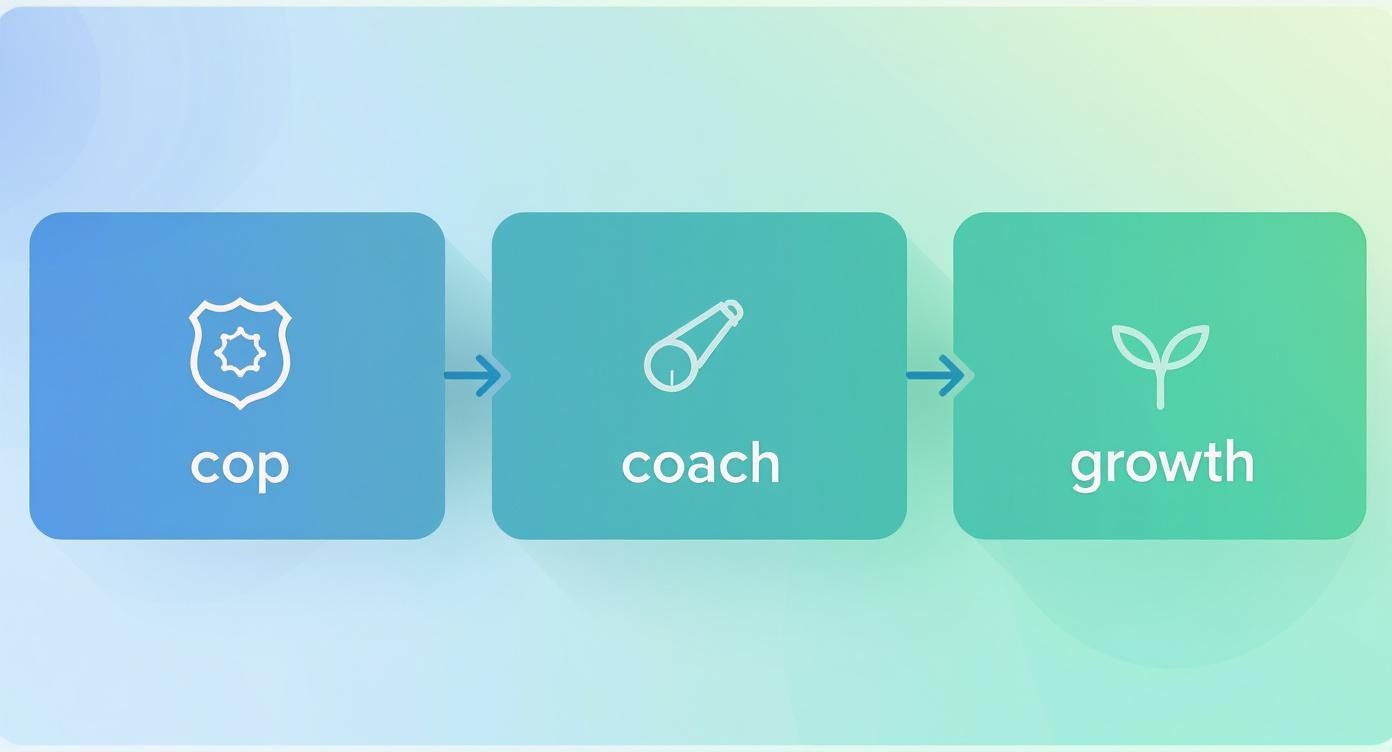
As the visual suggests, when technology handles the basic rule enforcement, the human side of QA can focus on nurturing skills and building a culture of continuous improvement.
By automatically transcribing every conversation, these systems create a searchable, text-based record of every customer interaction. To see how this works in practice, check out our guide on auto transcribe software and its benefits. This allows managers to quickly find examples, track keywords, and build a library of "gold standard" calls for training, turning every single interaction into a learning asset for the whole company.
To put this all into perspective, let's look at a direct comparison of the old way versus the new.
Manual QA vs AI-Powered QA
As you can see, the difference is stark. AI doesn't just make the old process faster; it fundamentally changes what's possible, elevating QA from a simple compliance function to a strategic driver of business intelligence and agent excellence.
Navigating the Common Hurdles in Call Center QA
Even the best-laid plans for a call center quality assurance program can hit a few bumps in the road. Getting a new system off the ground involves more than just new tech and scorecards; you're dealing with people, old habits, and the need to show real results. Knowing what these roadblocks are ahead of time is half the battle.
Getting past these issues usually comes down to good communication, solid data, and a commitment to coaching, not just catching mistakes. Here’s a look at the most common challenges that can trip up an otherwise strong QA program, and how to get around them.
Keeping Your Evaluators on the Same Page
Nothing kills an agent's trust in a QA program faster than inconsistent scoring. It’s incredibly frustrating when one agent gets a great score for handling a call a certain way, while another gets marked down for doing the exact same thing. This almost always happens when "good" is left up to interpretation.
The best way to fix this? Regular calibration sessions. Seriously, don't skip these. Get all your evaluators in a room to score the same call, then have them talk through why they scored the way they did. This process forces everyone to align on a single, shared standard.
Calibration is more than just getting scores to line up. It's about building a unified vision of what quality actually means for your team. This ensures every agent is measured by the same ruler, which makes the whole process feel fair and legitimate.
Doing this consistently irons out personal biases and makes sure the feedback an agent receives is dependable, no matter who's doing the review.
Dealing with Agent Defensiveness
Let's be honest, no one loves being critiqued. It’s human nature to get a little defensive, especially if past QA felt more like a "gotcha" exercise. The trick is to completely change the dynamic from a performance review into a coaching session focused on specific, changeable behaviors.
Always, always back up your feedback with concrete examples. Don't say, "You sounded rude." Instead, try something like, "On that call at 2:15 PM, I noticed the customer had to repeat their question three times. Let's talk about some ways we can make sure we've got all the details on the first go."
This simple shift does a few powerful things:
- It’s about action, not personality: You're discussing what the agent did, not who they are. Actions can be changed; personality traits are a much heavier topic.
- It’s based on facts: Using real moments from a call takes the guesswork and personal opinion out of it. It’s hard to argue with a recording.
- It builds a partnership: This positions the QA specialist as a coach—someone in the agent's corner, helping them get better—not as a judge.
Showing That QA Is Worth the Investment
At the end of the day, the people signing the checks need to know that call center quality assurance is money well spent. To prove its value, you have to draw a straight line from your quality scores to the company's bottom-line goals.
Start by looking for connections between your QA data and your key business metrics. For example, can you show that a 10% jump in First Call Resolution scores—thanks to better coaching—coincided with a 5% drop in customer churn? When you can link your team's hard work to tangible wins like keeping more customers or boosting sales, QA stops looking like a cost and starts looking like a powerful engine for growth.
Your Call Center QA Questions Answered
How Many Calls Should We Be Evaluating Per Agent?
This is a classic question, and the answer isn't set in stone. However, a solid rule of thumb is to review about 5-10% of each agent's monthly calls. For an agent handling around 300 calls in a typical week, that works out to be roughly 30 calls per month.
This volume gives you enough data to spot trends and identify coaching opportunities without bogging your QA team down in an endless cycle of reviews.
What’s the Difference Between Quality Assurance and Quality Control?
It's easy to use these terms interchangeably, but they represent two very different sides of the same coin. Think of it this way: Quality Assurance is proactive, while Quality Control is reactive.
Quality Assurance (QA) is all about the big picture. It’s the ongoing process of coaching, development, and refining your systems to help agents grow. QA builds skills for the long haul.
Quality Control (QC), on the other hand, zeroes in on the details of individual calls. It’s focused on compliance checks and catching specific errors to ensure standards are met right now. QC is about immediate accuracy and protecting your brand.
While QA boosts long-term performance, QC secures the here-and-now. You really need both to run a successful contact center.
How Can We Get Agents to Buy into the QA Process?
Getting agents on board with QA is crucial. If they see it as a "gotcha" system, you'll get pushback. The trick is to frame it as a tool for their own growth, not just a compliance task.
Here are a few ways to make that happen:
- Make it a game: Gamified scorecards and interactive leaderboards can spark a little friendly competition.
- Encourage peer learning: Set up peer mentoring or run monthly calibration sessions led by your top-performing agents. This shows everyone what "great" looks like in a practical way.
- Celebrate wins: Publicly recognize your "QA champions" in team meetings. A little positive reinforcement goes a long way in boosting morale.
What Should We Do When Quality Scores Are Dropping?
A dip in quality scores can be alarming, but don't panic. The first step is to dig into the data to understand the why. Start by looking at your recent calibration sessions and agent feedback to see if you can spot any patterns.
Often, you’ll find a mismatch between your scorecard and what agents are actually facing on calls. Maybe there's a new product issue causing confusion or a process flaw that's tripping everyone up. Pinpointing that root cause is half the battle.
Once you know what’s going on, you can take targeted action. This could be a focused coaching session on a specific skill or even a small adjustment to the scorecard itself. A quick workshop can often realign expectations and get everyone back on track.
When your scorecard reflects the real challenges agents face every day, you'll see a real-world improvement in your QA scores.
This is where AI transcription tools can be a massive help. By converting call audio into searchable text, your QA team can instantly flag key phrases, spot trends automatically, and find the exact interactions they need to review. This frees them up from tedious manual listening so they can spend more time on what actually matters: coaching your team.
Explore how HypeScribe can accelerate your QA transcription.



